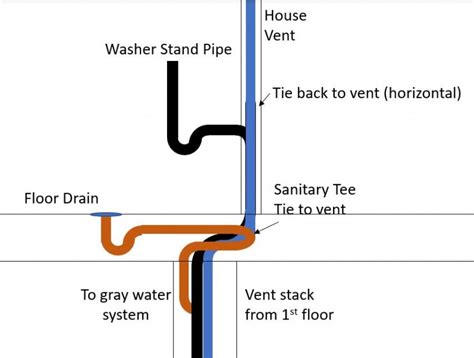How To Vent A Floor Drain
Ronan Farrow
Apr 03, 2025 · 3 min read

Table of Contents
How to Vent a Floor Drain: A Comprehensive Guide
A properly vented floor drain is crucial for efficient drainage and preventing sewer gas from entering your home. A clogged or improperly vented drain can lead to slow drainage, gurgling sounds, and even unpleasant odors. This guide will walk you through the process of venting a floor drain, covering everything from identifying the problem to completing the installation.
Identifying the Need for Floor Drain Venting
Before you begin any work, it's essential to pinpoint the root cause of your drainage issues. Several signs indicate that your floor drain needs venting:
- Slow Drainage: Water drains slowly or not at all.
- Gurgling Sounds: You hear gurgling or bubbling sounds from the drain.
- Sewer Gas Odors: You detect unpleasant sewer gas smells emanating from the drain.
- Backups: Wastewater backs up into the drain.
If you're experiencing any of these problems, a poorly vented drain is a strong possibility. However, it's important to rule out other potential causes, such as clogs in the drainpipe itself. Try using a drain snake or chemical drain cleaner to clear any obstructions before assuming venting is the solution.
Understanding Vent Pipes and Their Function
Vent pipes are crucial components of any plumbing system. Their primary function is to equalize air pressure within the drainage system. Without proper venting, air pressure can build up, hindering the flow of wastewater. This is especially critical for floor drains, which are often located at low points in the plumbing system. A vent allows air to enter the system, preventing a vacuum from forming and ensuring efficient drainage.
Methods for Venting a Floor Drain
There are a few different methods for venting a floor drain, depending on your existing plumbing setup and the location of the drain.
1. Adding a Vent Stack to an Existing System
This is the most common method. A vent stack is a vertical pipe that extends from the drainpipe to the roof. It creates a continuous path for air to enter and exit the system. Adding a vent stack requires expertise; it is best handled by a qualified plumber who can ensure proper installation and compliance with local building codes.
2. Using a Loop Vent
A loop vent is a simpler solution that uses a section of pipe that runs horizontally above the drainpipe to create a vent. A loop vent doesn't require a connection to the roof but still allows air to enter the system. Its suitability depends on the layout of your plumbing system and may not be practical in all situations.
3. Utilizing a Studor Vent
Studor vents are self-regulating air admittance valves. They are relatively easy to install and allow air into the system only when needed. They are typically used in situations where running a traditional vent stack is difficult or impossible. However, it's important to note that these vents should not be solely relied upon to solve more significant venting issues.
Choosing the Right Vent Method
The best venting method for your floor drain depends on several factors:
- Existing Plumbing: The configuration of your existing drain and vent system.
- Location of the Drain: The location of the drain relative to other plumbing fixtures.
- Accessibility: The accessibility of the area for installation.
- Local Building Codes: Compliance with local building codes and regulations.
Consulting with a licensed plumber is strongly recommended to determine the most suitable and code-compliant venting solution for your specific situation. Improper venting can lead to serious plumbing problems down the line.
Maintaining Your Floor Drain Vent
Regular maintenance is essential to prevent future problems. This includes:
- Regular Cleaning: Keep the drain free of debris and clogs.
- Inspection: Periodically inspect the vent pipe for any damage or blockages.
- Professional Inspection: Schedule a professional plumbing inspection every few years to ensure your venting system is functioning correctly.
By understanding the importance of proper venting and following these guidelines, you can ensure your floor drain functions efficiently and prevents potentially costly plumbing issues. Remember, while some simpler solutions might seem DIY-friendly, complex venting issues necessitate professional intervention. Always prioritize safety and code compliance.
Featured Posts
Also read the following articles
| Article Title | Date |
|---|---|
| How To Use Haakaa To Increase Supply | Apr 03, 2025 |
| How To Use Tinks 69 | Apr 03, 2025 |
| 2 Howe Drive Amherst Nh | Apr 03, 2025 |
| How To Write Emory Supplements | Apr 03, 2025 |
| How Big Is A Poker Table | Apr 03, 2025 |
Latest Posts
-
How Far Is Distribution Box From Septic Tank
Apr 04, 2025
-
How Far Is Cuba From Key West By Boat
Apr 04, 2025
-
How Far Is Cinnamon Beach From St Augustine
Apr 04, 2025
-
How Far Is Carriacou From Grenada
Apr 04, 2025
-
How Far Is Beach From Me
Apr 04, 2025
Thank you for visiting our website which covers about How To Vent A Floor Drain . We hope the information provided has been useful to you. Feel free to contact us if you have any questions or need further assistance. See you next time and don't miss to bookmark.
